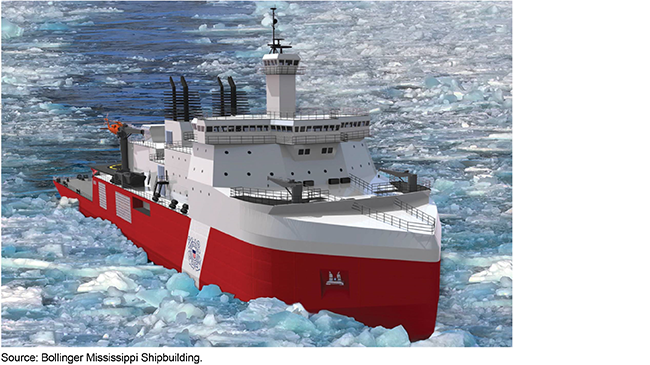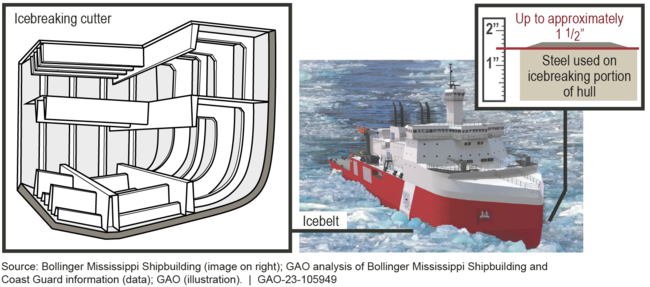Coast Guard Acquisitions: Polar Security Cutter Needs to Stabilize Design Before Starting Construction and Improve Schedule Oversight
Fast Facts
The Coast Guard's only active heavy polar icebreaker, the aging Polar Star, primarily helps ensure U.S. access to Antarctica. The Coast Guard is working to design and build 3 Polar Security Cutters to replace it.
The U.S. hasn't built a heavy polar icebreaker in almost 50 years, creating challenges with designing and understanding how to build the cutters. Challenges—such as designing the hull to withstand icebreaking—extended the design phase by at least 3 years and delayed construction start.
To help the Coast Guard avoid costly rework and further delays, we recommended stabilizing the ship's design before starting construction.
Shipyard’s Rendering of a Polar Security Cutter

Highlights
What GAO Found
The Polar Security Cutter's (PSC) design is not yet mature, which has led to an extended design phase and contributed to a 3-year schedule delay in the shipyard, with construction of the first cutter now planned for March 2024. Coast Guard officials attribute the extended design phase to various challenges. For example, icebreaking hulls require thick steel—up to twice as thick as a non-icebreaker—and a dense framing structure that has been challenging to plan for the PSC. Additionally, Coast Guard officials stated that U.S.-based shipbuilders have limited expertise designing and building heavy polar icebreakers.
Notional Depiction of the Polar Security Cutter's Thick Hull and Dense Framing

Starting construction with an immature design is contrary to leading practices. In another ongoing Coast Guard program, GAO found that construction started before the design was mature, resulting in costly rework and schedule delays.
The PSC program likely has unreliable schedule and cost estimates. The primary reasons are:
- The acquisition program baseline includes a delivery date for the first PSC but not for the third PSC. At a minimum, without a delivery date for the third cutter, the Department of Homeland Security (DHS) may have fewer opportunities for oversight if the program experiences schedule delays in the years before the program is expected to be declared fully operational.
- Key shipyard business systems that track labor hours, costs, and schedule performance were determined not to be acceptable for use, which affects the reliability of data. The Coast Guard and shipyard are taking steps to address the data limitations and GAO will continue to monitor progress.
The Coast Guard intends for its sole remaining, almost 50-year-old heavy polar icebreaker, the Polar Star, to be available until at least the second PSC is operational. The Coast Guard has efforts underway to maintain and extend the life of this cutter. However, the Polar Star 's deteriorating systems present challenges, with top issues related to propulsion and electrical systems. The Coast Guard's assessments of the hull found it in good structural condition.
Why GAO Did This Study
The U.S. Coast Guard, a component within DHS, has stated that it does not have enough polar icebreakers to meet its missions in the Arctic and Antarctic. To address the gap, the Coast Guard is partnering with the Navy to procure three heavy polar icebreakers, known as Polar Security Cutters. The Coast Guard plans to invest at least $11.6 billion for acquisition, operations, and maintenance of these cutters.
GAO was asked to review the acquisition of the PSC, including the progress of the design phase, and efforts to maintain and extend the life of the Polar Star, the current active heavy polar icebreaker. This report addresses the (1) factors that contributed to the PSC program's design delays, (2) extent to which the program has established realistic schedule and cost baselines, and (3) status of efforts to maintain and extend the life of the Polar Star until the PSCs are operational. GAO reviewed Coast Guard program and contract documentation and interviewed PSC and Navy program officials, as well as shipbuilder representatives.
Recommendations
GAO is making two recommendations, including that DHS ensures the design is sufficiently mature before the Coast Guard starts cutter construction and that DHS ensures the Coast Guard adds the third PSC delivery date into its acquisition program baseline. DHS concurred with both recommendations.
Recommendations for Executive Action
| Agency Affected | Recommendation | Status |
|---|---|---|
| Department of Homeland Security |
Priority Rec.
The DHS Secretary should ensure the DHS Under Secretary for Management ensures design for the lead PSC is mature, meaning at least the functional design is complete, including routing of major distributive systems that affect multiple zones of the ship, prior to authorizing lead cutter construction beyond the previously approved eight prototype units. (Recommendation 1) |
DHS agreed with this recommendation. DHS stated that the Department's goal for the Polar Security Cutter's design maturity is consistent with this recommendation-to complete functional design, including routing of major distributive systems that affect multiple zones of the ship prior to authorizing construction of the first ship. However, in April 2025, DHS approved the lead PSC to start construction at ADE 2C with 95 percent of the functional design complete. Officials said that some portions of the incomplete functional design included routing of major distributive systems that affect multiple zones of the ship. We stand by this recommendation as it aligns with our leading practices in shipbuilding, but there is no longer an opportunity for the Coast Guard to implement in advance of lead ship construction.
|
| Department of Homeland Security | The DHS Secretary should ensure the DHS Under Secretary for Management ensures the Coast Guard adds the delivery date for the third PSC to the acquisition program baseline as soon as practical. (Recommendation 2) |
DHS agreed with this recommendation. In January 2025, DHS approved an updated acquisition program baseline for the PSC program and added a preliminary delivery date for the third PSC in the baseline, demonstrating a step toward implementing this recommendation. Because the program cannot breach this preliminary date, it does not fully meet the intent of the recommendation. As of July 2025, the program had yet to update the baseline to reflect a final delivery date for PSC 3. Program officials indicated that they still needed to modify the contract for PSC 3. We will continue to follow-up on this recommendation to determine if the program's actions fully meet the intent of the recommendation.
|
